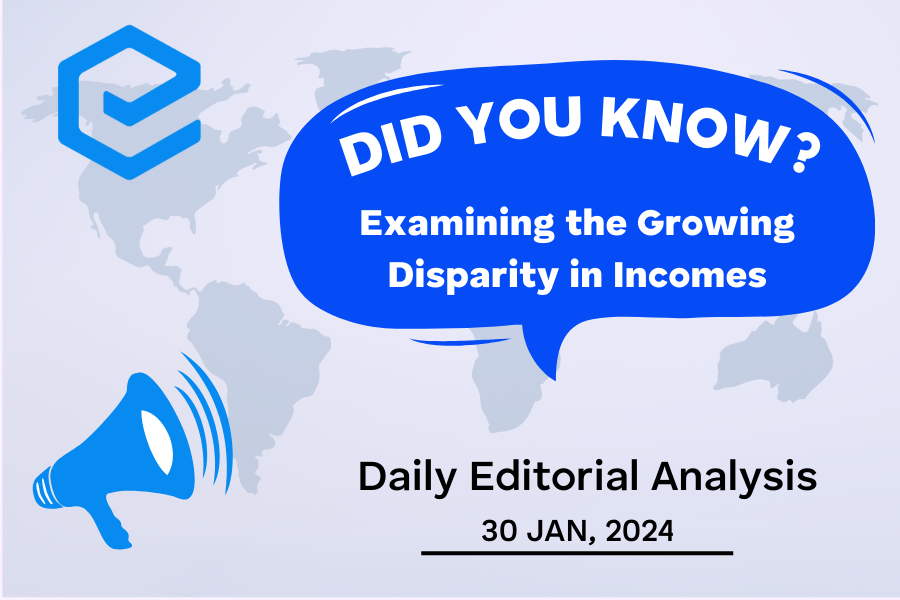
The widening gap in incomes has become an alarming societal issue that demands careful examination. In recent years, the disparity between the wealthy elite and the rest of the population has reached unprecedented levels, prompting concerns about its implications for social cohesion and economic stability. This growing income inequality can be attributed to various factors, including technological advancements, globalization, and policy decisions that disproportionately favor the affluent. As the rich accumulate wealth at an accelerating pace, a significant portion of the population struggles to meet basic needs, leading to increased social tensions. It is imperative that policymakers and society as a whole address this issue comprehensively, implementing measures that promote fair economic opportunities and create a more equitable distribution of resources. Failure to address the root causes of income disparity may result in long-lasting negative consequences for both individuals and the overall stability of our communities.
Tag: GS-3 Economy, Inequality
Contents
- 1 Assessment of SBI’s Report on Reduction in Inequality
- 2 Conclusion
- 3 Frequently Asked Questions (FAQs)
- 3.1 Q1: What is driving the growing disparity in incomes?
- 3.2 Q2: How does income inequality impact society?
- 3.3 Q3: Are there regional variations in income inequality?
- 3.4 Q4: Can education play a role in reducing income inequality?
- 3.5 Q5: What role can government policies play in mitigating income disparity?
- 4 In case you still have your doubts, contact us on 9811333901.
In News:
The recent report from the State Bank of India (SBI) underscores a significant decline in income inequality in India over the last ten years.
Assessment of SBI’s Report on Reduction in Inequality
- Gini Coefficient Reduction
- The SBI report highlights a significant reduction in the Gini coefficient, measuring income inequality, from 0.472 in 2014-15 to 0.402 in 2022-23.
- Magnitude of Change
- The 15% drop in the Gini coefficient signifies substantial improvement in income equality over a decade, indicating a sustained trend.
- Positive Implications
- A reduced Gini coefficient is viewed positively, suggesting progress toward more equitable income distribution.
- Implications for policymakers include potential success in addressing disparities through economic policies or social programs.
A Critical Assessment of SBI Report
- Taxpayer Data Limitations
- Concerns arise due to the reliance on taxpayer data, excluding about 80% of income-earners below taxable thresholds.
- Representativeness of findings is questioned, impacting the understanding of true income inequality.
- Exclusion of Low-Income Earners
- SBI’s analysis excludes low-income individuals, a substantial portion of the population.
- This exclusion raises concerns about accurately representing economic conditions.
- Sensitivity to Economic Disparities
- Critics suggest economic disparities within the taxpayer base may influence the reported reduction in the Gini coefficient.
- Accuracy of findings may be compromised if a significant portion of low-income individuals is excluded.
- Absence of Supplementary Data
- Critics propose incorporating additional sources like Periodic Labour Force Survey (PLFS) data.
- PLFS can offer a holistic view of income distribution, considering a broader spectrum of earners.
- Analysis of Reduction in Inequality According to PLFS Data
- PLFS records gross incomes of self-employed, allowing a detailed analysis.
- Gini coefficient decline is observed, but income inequality among top earners may have fallen more than the general population.
Polarisation of Incomes
- Divergence in Income Growth
- Top decile’s income grows faster than the bottom 20%, leading to income divergence.
- The 90/10 ratio increases, indicating a wider gap between top and bottom incomes.
- Rise in Women’s Labor Force Participation
- Contradictory findings may be linked to the documented rise in women’s labour force participation, particularly in low-paid self-employed work.
- Increased Household Earnings
- While households earn more due to increased labour force participation, low-paid self-employed work contributes to income dynamics.
- Polarisation Among Income-Earners
- Increase in low-paid self-employed work contributes to polarisation among income-earners.
Conclusion
- While the reduced Gini coefficient is positive, income polarisation among the self-employed complicates the overall analysis.
- Policymakers should consider nuanced understanding of income dynamics for effective interventions.
Source: TH
Frequently Asked Questions (FAQs)
Q1: What is driving the growing disparity in incomes?
A1: The growing income disparity can be attributed to a combination of factors, including technological advancements favoring high-skilled workers, globalization leading to outsourcing and offshoring, and policy decisions that often benefit the wealthy.
Q2: How does income inequality impact society?
A2: Income inequality can have significant negative impacts on society, contributing to social unrest, reduced social mobility, and diminished overall economic growth. It can also result in disparities in access to education, healthcare, and other essential services.
Q3: Are there regional variations in income inequality?
A3: Yes, income inequality varies across regions due to factors such as local economic conditions, industrial composition, and regional policies. Urban areas, for instance, may experience higher income inequality compared to rural areas.
Q4: Can education play a role in reducing income inequality?
A4: Education is a crucial factor in addressing income inequality. Access to quality education and skill development programs can empower individuals to compete in the job market and reduce the gap between high and low-income earners.
Q5: What role can government policies play in mitigating income disparity?
A5: Government policies play a vital role in addressing income inequality. Implementing progressive tax systems, social welfare programs, and policies that promote inclusive economic growth can help reduce the growing gap in incomes and create a more equitable society.
In case you still have your doubts, contact us on 9811333901.
For UPSC Prelims Resources, Click here
For Daily Updates and Study Material:
Join our Telegram Channel – Edukemy for IAS
- 1. Learn through Videos – here
- 2. Be Exam Ready by Practicing Daily MCQs – here
- 3. Daily Newsletter – Get all your Current Affairs Covered – here
- 4. Mains Answer Writing Practice – here

